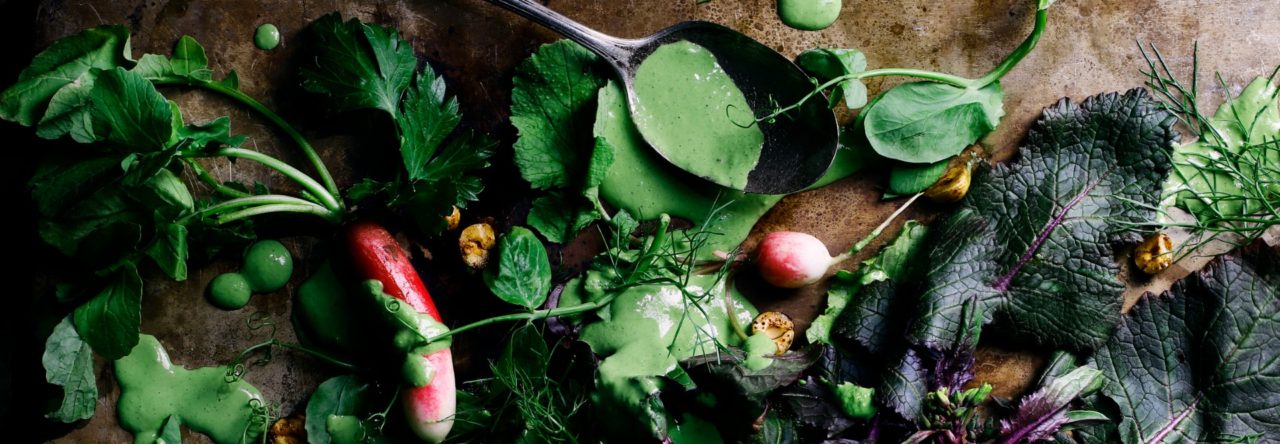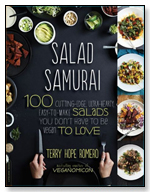Sizzling rice with mushrooms and spicy chile sauce (dolsot bibimbap)
Makes 2 generous servings
Korean hot stone bowl bimbimbap is one of my favorite meals to cobble together at home; restaurants present a gorgeous and complex version, but really even with just three ingredients it’s satisfying and fun to make in your own kitchen. While simply piling on the veggies and addictive fermented red chile sauce onto boiled rice is enough, sometimes it’s fun to take that extra step, pull out the cast iron skillet and make your own sizzling hot stone bowl rice, without the hot stone bowl.
Sure, you could purchase your own stone bowls, but your trusty well-cured cast iron skillet also does a great job and forming that essential crunchy, sizzling rice crust. Hard core cast iron fans might want to provide every guest with their own small individual pan, but preparing all the rice in a big cast iron Dutch oven gets the job done. The topping can be as few or many as you please, but the addition of mirin-braised trumpet mushrooms makes this veggie specialty a repeat performer dish on weekend evenings. Throwing on slivers of Pressed Baked Tofu or bulgogi-style mixed-grill seitan makes it extra hearty, but I enjoy the simplicity of spinach, sprouts and mushrooms most days.
The ingredients list may look epic, but almost all of the veggies are simply seasoned can be prepared while the rice is cooking and the sauce takes a minute to stir up. Many of the veggies can be prepared a day in advance. Make dolsot bibimbap and you’ll easily have everything ready to go by the time is done crisping. In the time it took me to write this recipe I could have had bibimbap on my lap!
Have a bibimbop party! Double or triple the rice (easily done with a rice cooker) and the toppings. Arrange a variety of pretty seasoned veggies on a big platter and pass around the bowls, chopsticks and individual servings of chili sauce.
Rice:
1 cup short grain white rice (sushi rice is fine), brown rice or Korean-style mixed grain rice
1 teaspoon sea salt
3 tablespoons toasted sesame oil (for dolsot bibimbap)
Gochujang sauce:
1/3 cup gochujang (Korean fermented red chile paste)
2-3 tablespoons warm water
Seasoned Trumpet Mushrooms, Seasoned Spinach and Sesame Scallions
Sesame Bean Sprouts
Additional garnish:
Homemade or purchased kimchi, thin strips of toasted nori seaweed, thin strips of Pressed Baked Tofu or Korean Mixed Grill Seitan, toasted sesame seeds
Recipe
1. Cook the rice with the salt according to package directions and keep warm. If you’re using a rice cooker this is easy enough; if on a stovetop keep the rice tightly covered and plan on eating the bimbimbap (or dolsot bibimbap) as soon as the veggie toppings are prepared.
2. Prepare the veggies first: the trumpet mushrooms, sesame bean sprouts and seasoned spinach. You can prepare these veggies up to 2 days in advance and keep each item tightly covered and chilled in the fridge until ready to use. Prepare the gochujang sauce; in a small mixing bowl stir together chile paste and water to form a smooth sauce. Add more water, a teaspoon at a time, until a consistency similar to ketchup is achieved.
3. For regular bibimbap, brush the insides of each large, deep serving bowl with a little toasted sesame oil and mound in the cooked rice. Arrange like a mound of each veggie topping (and tofu or seitan if using), like slices on top of a pie or in little piles. Scatter top of rice with nori strips or sesame seeds if using. Serve sliced kimchi on the side, and give each eater their own little dish of gochujang sauce and a large, wide soup spoon.
To eat bibimbap, spoon a healthy dollop of chile sauce on top of vegetables. Use the soup spoon to dig deep under the rice and mix the sauce into everything and eat immediately with chop sticks!
For sizzling dolsotbop, we’ll add in an extra important step:
1. Keep the cooked sushi rice, short grain brown or mixed grain rice warm until ready to use.
2. Heat a deep, 12 inch cast iron skillet or Dutch oven over medium-high heat; it’s ready to use when a drop of water flicked on the surface sizzles immediately. Using a pastry brush, brush the bottom and sides of the skillet with 2 tablespoons of toasted sesame oil. Now using a heat resistant rubber spatula or bamboo rice spatula, spread the cooked rice over the entire bottom of the pan to form a thick cake. Let the rice cook undisturbed for 3 minutes.
3. Arrange the veggies on top of the rice as described for regular bibimbap, and drizzle the top of the veggies with the remaining sesame oil. If necessary rotate the skillet a few times on the stovetop to help the rice evenly brown. Use a spatula to check underneath cooking rice; the bottom layer touching the pan should be sizzling and form a light golden, crunchy crust. If desired continue to cook the rice until a dark enough crust has formed to your liking. When you can’t take it anymore and you’re ready for your dolsot bibimbap, remove it from the stove, top with gochujang sauce and stir. Carefully pile servings into individual bowls and pass around additional toppings as desired.
Seasoned veggies:
Braised Trumpet Mushrooms
1 pound king or oyster mushrooms
3 tablespoons soy sauce
2 tablespoons mirin cooking wine
2 tablespoons water
1 teaspoon sugar
1. Brush off any soil from mushrooms and slice off hard stems or root bundles. Slice trumpet mushrooms into long slices about 1/4 inch thick; slice oyster and shitake mushroom tops into strips about 1/4 inch thick.
2. In a deep 12 inch skillet combine soy sauce, sake, water and sugar over medium high heat. Add mushrooms and use long handled tongs to stir to coat mushrooms with the marinade. When the marinade starts to simmer, cover mushrooms for 5 minutes. Remove the cover and continue to cook, stirring occasionally, until most of the liquid has been absorbed. Remove from heat and let cool. Mushrooms can be prepared a day in advance.
Seasoned Spinach
1 pound spinach, cleaned thick stems removed
2 tablespoons soy sauce
2 teaspoons rice vinegar
2 teaspoon sugar
½ teaspoon toasted sesame oil
1. Place spinach in a large metal colander in the sink. Boil 2 quarts of water and pour over spinach to wilt, then rinse with cold water to stop the cooking. Squeeze the spinach to remove excess water and place in a bowl.
2. Pour remaining ingredients over spinach and toss to coat. This spinach can be made a day in advance.
Sesame Scallions
2 cups trimmed scallions, green and white parts
1 tablespoon soy sauce
1 tablespoon rice vinegar
2 teaspoons sesame seeds
pinch sugar
1. Slice scallions very thin on 45 degree angle; you want long, thin slivers. Place in a mixing bowl, add remaining ingredients and toss to coat. This is best made right before serving.
Variations
Bibimbap is ready for your culinary experimention; the combinations of rice and vegetables married with gochuchang sauce will keep you busy for many meals.
Steamed sticky rice is a great alternative to regular sushi rice. Look for exciting blends featuring a mix of grains such as millet, sorguhm, red or black short grain rice and all kinds of beans on Korean grocery shelves. Most any sticky rice blend can be prepared by soaking 4 hours or overnight and steaming (see steaming sticky rice).
Roasted kabocha topping
A favorite warm, sweet topping for cold weather dolsot bibimbap meals
1 pound kabocha squash (about 1 small squash), seeded and diced into small 1/2 inch chunks
2 tablespoons peanut oil
1/2 teaspoon toasted sesame oil
1/2 teaspoon salt
1. Preheat oven to 400 degrees. Spread diced kabocha squash onto a large baking sheet, sprinkle with peanut oil and teaspoon sesame oil and toss to coat. Roast for 30-40 minutes, stirring occasionally, till squash is tender and lightly browned. Remove from oven and set aside. Sprinkle with a little kosher salt.
Zucchini: roasted zucchini sliced into 1/2 pieces like the kabocha until tender and golden.
Cucumber: Use long, seedless cucumbers. Peel and slice into batons. Toss with a pinch of sugar, a dusting of sea salt, a splash of sake or mirin and a teaspoon of rice vinegar. Use immediately.
Asian pear: Core and slice into batons one large pear, then quickly toss to coat with 2 teaspoons lemon juice and a pinch of sea salt. Just like the cucumber, eat this topping as soon as possible.








